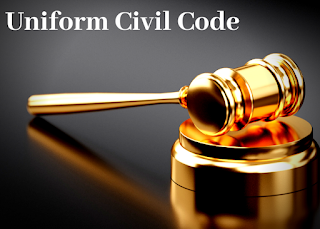This
article will be discussing about the concept Uniform Civil Code under the Constitution
of India.
1.
INTRODUCTION:
The
term ‘Uniform Civil Code’ is the proposal to replace the personal laws
based on the scriptures and customs of each major religious community in the
country with a common set governing every citizen. A society with stable norms
is simply inconceivable without some kind of uniformity of the rules of conduct
governing multiple relationships of members of united.
Early
Indian societies demonstrated both uniform rules of social relationship and the
norms which suffered from discrimination and prejudices.
India
has been for centuries a multi-religious and multi-ethnic society and yet it
has the distinction of maintaining unity in such diversities. But Indian
history also affords traces of religious and ethnic tensions and conflicts besides
that harmony. When the Englishmen entered the Indian scenario as our lords,
undoubtedly, they influenced certain social norms of the Indians in general
through their overbearing political and social attitudes but such influences
could not subside to the increasing religious and ethnic tensions. Ultimately,
when the British domination came to an end in 1947 it left behind that tension
in an accentuated form which was product of their political formula for
independence of India.
At
the same time, India was politically divided into two independent countries,
viz., Pakistan and India - a division based on the consideration of the
religion-oriented politics. After this political division, Indian social setup
and norms of the society were seen in the conspectus of the newly adopted
constitution of India in which concept of welfare state came to substitute the
concept of police state. With the adoption and enforcement of the constitution
in 1950, started a new era in the formation of new social norms in which state
has been declared as insurer and guardian of the citizen.
Justice,
liberty, democracy, equality and fraternity were declared
as the goals to be achieved by the supreme law of the land. The chapters of fundamental
rights and directive principles of state policy were incorporated for
fulfilment of those constitutional goals.
These
directives impose on the state of the duty to take positive actions in certain
directions to promote the welfare of the people and to achieve economic
independence. The chapter on fundamental rights imposes certain restrictions on
the state as against the individual citizen in order to promote the welfare
state of present free India.
Thus,
to arrest the country’s sufferings from a congeries of religion and sect, the
farmers of the constitution tried their best to obviate some of urgent social
problems, by incorporating certain provisions. Article 44 is one of them and it
envisages the unification of civil law this very article lays down the
following directive for the state that “The state shall Endeavour to secure
for the citizens a Uniform Civil Code throughout the territory of India.”
2.
MEANING OF CIVIL CODE:
The
phrase "Uniform Civil Code" of India refers to the idea of an
overarching Civil Law, and the phrase "Civil law" refers to a legal framework
influenced by Roman law. In accordance with the civil law principle, all
citizens must have access to a written compilation of the laws that apply to everyone
equally and without exception. The same set of secular civil laws, regardless of
a person's region or religious affiliation, are applied by the uniform civil
code to all citizens.
3.
NATURE AND SCOPE OF ARTICLE 44 OF THE CONSTITUTION.
The
concept of uniform civil code has been indulged in Part-iv of the Constitution
which dealing with the Directive Principle of State Policy. Article 37 of
Constitution has clearly said that the Directive Principle will not be enforceable
before the Court of Law. It is the reminder to the state that contains the potentials
to establish the welfare state.
Article
44 of the Indian Constitution states “the State shall endeavour to secure
for the citizens a uniform civil code through the territory of India”.
This
Article requires on the State to take steps for establishing a uniform civil
code throughout the territory of India. two objectives were put forward
in the Constituent Assembly against the making of a uniform civil code
applying throughout India:
Firstly,
it would infringe the fundamental right to freedom of religion mentioned in Article
25 and
Secondly,
it would be a tyranny to the minority.
4.
SUBJECT MATTERS OF UNIFORM CIVIL CODE:
It
is significant to note that the term "civil code" refers to the
entire body of laws that regulate property rights as well as other aspects of private
life, such as marriage, divorce, maintenance, adoption, and inheritance. Here are
some matters covered by the Uniform Civil Code:
- Marriage, Divorce and Other matrimonial clauses;
- Succession (Inheritance);
- Guardianship;
- Maintenance;
- Adoption;
- Partition;
- Gifts and Wills;
- Religious institutions;
- Joint Family System; and matters of Charitable trust, etc.
The
demand for a uniform civil code essentially entails combining all of these
personal laws into a single body of secular law that governs these matters and is
applicable to all Indian citizens, regardless of their affiliation with a particular
community.
In
India, the Supreme Court first directed the Parliament to frame a uniform civil
code in the year 1985 in the case of Mohammad Ahmed Khan v. Shah Bano
Begum, popularly known as the Shah Bano case.
In
that case, a indigent Muslim woman who had received triple talaq from her
husband filed a maintenance claim against him under Section 125 of the Code of
Criminal Procedure. The Supreme Court held that the Muslim woman have a right
to get maintenance from her husband under Section 125.
The
second instance in which the Supreme Court again directed the government of
Article 44 in the case of Sarla Mudgal v. Union of India (1995). In that case, the question was whether a Hindu
husband, married under the Hindu law, by embracing Islam, can solemnize second
marriage The Court held that a Hindu marriage solemnized under the Hindu law
can only be dissolved on any of the grounds specified under the Hindu Marriage
Act, 1955. Conversion to Islam and Marrying again would not, by itself,
dissolve the Hindu marriage under the Act. And, thus, a second marriage
solemnized after converting to Islam would be an offence under Section 494 of
the Indian Penal Code, 1860.
5.
CONCLUSION:
Article
44 contained in part IV of the Constitution says that the state “shall
endeavour to secure for the citizens a uniform civil code throughout the
territory of India”. While there is no draft or model document yet for the
UCC, the framers of the Constitution envisioned that it would be a uniform set
of laws that would replace the distinct personal laws of each religion with
regard to matters like marriage, divorce, adoption, and inheritance. Part IV of
the Constitution outlines the Directive Principles of State Policy, which,
while not enforceable or justiciable in a court of law, are fundamental to the
country’s governance.



.png)
.png)

No comments:
Post a Comment